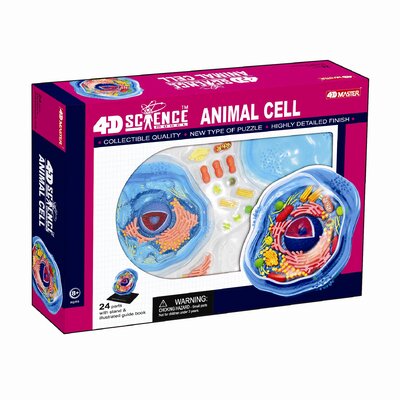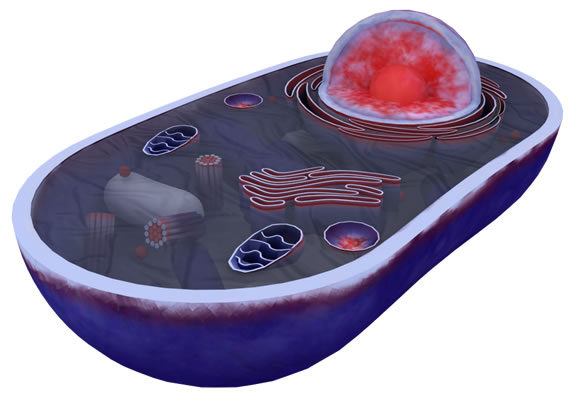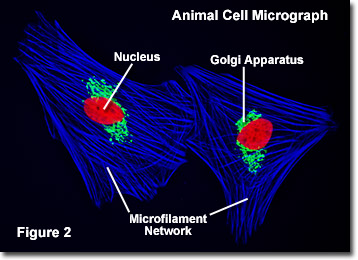What Is A Animal Cell Biography
Source:- Google.com.pk
The scale of operation of freely suspended animal cell culture has been increasing and in order to meet the demand for recombinant therapeutic products, this increase is likely to continue. The most common reactor types used are stirred tanks. Air lift fermenters are also used, albeit less commonly. No specific guidelines have been published for large scale (≥10 000 L) animal cell culture and reactor designs are often based on those used for microbial systems. However, due to the large difference in energy inputs used for microbial and animal cell systems such designs may be far from optimal. In this review the importance of achieving a balance between mixing, mass transfer and shear effects is emphasised. The implications that meeting this balance has on design of vessels and operation, particularly in terms of strategies to ensure adequate mixing to achieve homogeneity in pH and dissolved gas concentrations are discussed.
Full Text
The Full Text of this article is available as a PDF (295K).
Selected References
These references are in PubMed. This may not be the complete list of references from this article.
Ade Bello R, Robinson CW, Moo Young M. Liquid circulation and mixing characteristics of air lift contactors. Canadian Journal Chemical Engineering. 1984;62:573–577.
Ade Bello R, Robinson CW, Moo Young M. Prediction of the volumetric mass transfer coefficients in pneumatic contactors. Chem Eng Sci. 1985;40(1):53–58. doi: 10.1016/0009-2509(85)85046-6. [Cross Ref]
Ade Bello R, Robinson CW, Moo Young M. Gas holdup and overall volumetric transfer coefficient in airlift contactors. Biotech Bioeng. 1985;27:369–381. doi: 10.1002/bit.260270323. [PubMed] [Cross Ref]
Adler I, Schugerl K. Cultivation of E-coli in single and ten-stage tower-loop reactors. Biotech Bioeng. 1983;25:417–436. doi: 10.1002/bit.260250210. [PubMed] [Cross Ref]
Al-Rubeai M, Singh MH, Goldman MH, Emery AN. Death mechanisms of animal cells in conditions of intensive agitation. Biotech Bioeng. 1995;45:463–472. doi: 10.1002/bit.260450602. [PubMed] [Cross Ref]
Asai T, Sano T, Itoh K. Scale up of fermentation. Biotech Forum Europe. 1992;9(9):556–550.
Aunins JG, Woodson BA, Hale TK, Wang DIC. Effects of paddle impeller geometry on power input and mass transfer in small scale animal cell culture vessels. Biotech Bioeng. 1989;34:1127–1132. doi: 10.1002/bit.260340902. [PubMed] [Cross Ref]
Aunins JG, Henzler HJ. Aeration in cell culture bioreactors, Chapter 11. In: Stephanopoulos G, editor. Biotechnology V 3: Bioprocessing. Weinheim, Germany: VCH; 1993. pp. 219–281.
Backer MP, Metzger LS, Slaber PL, Nevitt KL, Boder GB. Large scale production of monoclonal antibodies in suspension culture. Biotech Bioeng. 1988;32:993–1000. doi: 10.1002/bit.260320807. [PubMed] [Cross Ref]
Bajpai RK, Reuss M. Coupling of mixing and microbial kinetics for evaluating the performance of bioreactors. Canadian Journal Chemical Engineering. 1982;60:384–392.
Bakker WAM, van Can HJL, Tramper J, de Goijer CD. Hydrodynamics and mixing in a multiple air lift loop reactor. Biotech Bioeng. 1993;42:994–1001. doi: 10.1002/bit.260420810. [PubMed] [Cross Ref]
Bakker WAM, den Hertog M, Tramper J, de Gooijer CD. Oxygen transfer in a multiple air-lift loop reactor. Bioprocess Engineering. 1995;12:167–172.
Birch JR, Bonnerjea J, Flatman S, Vranch S. The production of monoclonal antibodies, Chapter 5. In: Birch JR, Lennox ES, editors. Monoclonal antibodies. New York, U.S.A.: Wiley-Liss; 1995. pp. 231–265.
Birch JR, Thompson PW, Lambert K, Boraston R. The large scale cultivation of hybridoma cells producing monoclonal antibodies. In: Feder J, Tolbert WR, editors. Large scale mammalian cell culture. Orlando: Academic Press Inc; 1985. pp. 1–16.
Blenke H. Loop reactors. In: Ghose TK, Fiechter A, Blakebrough N, editors. Advances in Biochemical Engineering. New York, U.S.A.: Springer Verlag; 1979. pp. 121–214.
Bliem R, Katinger H. Scale up engineering in animal cell technology: Part I. Trends in Biotechnology. 1988;6:190–195. doi: 10.1016/0167-7799(88)90045-5. [Cross Ref]
Bliem R, Katinger H. Scale up engineering in animal cell technology: Part II. Trends in Biotechnology. 1988;6:224–230. doi: 10.1016/0167-7799(88)90078-9. [Cross Ref]
Boraston R, Thompson PW, Garland S, Birch JR. Growth and oxygen requirements of antibody producing mouse hybridoma cells in suspension culture. Develop Biol Standard. 1984;55:103–111. [PubMed]
Born C, Zhang Z, Al-Rubeai M, Thomas CR. Estimation of disruption of animal cells by laminar shear stress. Biotech Bioeng. 1992;40:1004–1010. doi: 10.1002/bit.260400903. [PubMed] [Cross Ref]
Borys MC, Linzer DIH, Papoutsakis ET. Ammonia affects the glycosylation patterns of recombinant mouse placental lactogen-I by chinese hamster ovary cells in a pH dependent manner. Biotech Bioeng. 1994;43:505–514. doi: 10.1002/bit.260430611. [PubMed] [Cross Ref]
Broad DF, Brown ME, Grant AP and Wood LA (1989) Scale up of mammalian call culture, in Advances in Animal Cell Biology and Technology for Bioprocesses, Spier RE, Griffiths JB, Stephenne J and Crooy PJ (Eds) pp. 412-415.
Byun TG, Zeng AP, Deckwer WD. Reactor comparison and scale-up for the microaerobic production of 2,3-butanediol by enterobacter aerogenes at constant oxygen transfer rate. Bioprocess Engineering. 1994;11:167–175.
Chalmers JJ. Cells and bubbles in sparged bioreactors. Cytotechnology. 1994;15:311–320. doi: 10.1007/BF00762406. [PubMed] [Cross Ref]
Chang YHD, Grodzinsky AJ, Wang DIC. Nutrient enrichment and in-situ waste removal through electrical means for hybridoma cultures. Biotech Bioeng. 1995;47:319–326. doi: 10.1002/bit.260470306. [PubMed] [Cross Ref]
What Is A Animal Cell Animal Cell Model Diagram Project Parts Structure Labeled Coloring and Plant Cell Organelles Cake


What Is A Animal Cell Animal Cell Model Diagram Project Parts Structure Labeled Coloring and Plant Cell Organelles Cake


What Is A Animal Cell Animal Cell Model Diagram Project Parts Structure Labeled Coloring and Plant Cell Organelles Cake


What Is A Animal Cell Animal Cell Model Diagram Project Parts Structure Labeled Coloring and Plant Cell Organelles Cake


What Is A Animal Cell Animal Cell Model Diagram Project Parts Structure Labeled Coloring and Plant Cell Organelles Cake


What Is A Animal Cell Animal Cell Model Diagram Project Parts Structure Labeled Coloring and Plant Cell Organelles Cake


What Is A Animal Cell Animal Cell Model Diagram Project Parts Structure Labeled Coloring and Plant Cell Organelles Cake


What Is A Animal Cell Animal Cell Model Diagram Project Parts Structure Labeled Coloring and Plant Cell Organelles Cake


What Is A Animal Cell Animal Cell Model Diagram Project Parts Structure Labeled Coloring and Plant Cell Organelles Cake


What Is A Animal Cell Animal Cell Model Diagram Project Parts Structure Labeled Coloring and Plant Cell Organelles Cake


What Is A Animal Cell Animal Cell Model Diagram Project Parts Structure Labeled Coloring and Plant Cell Organelles Cake
No comments:
Post a Comment